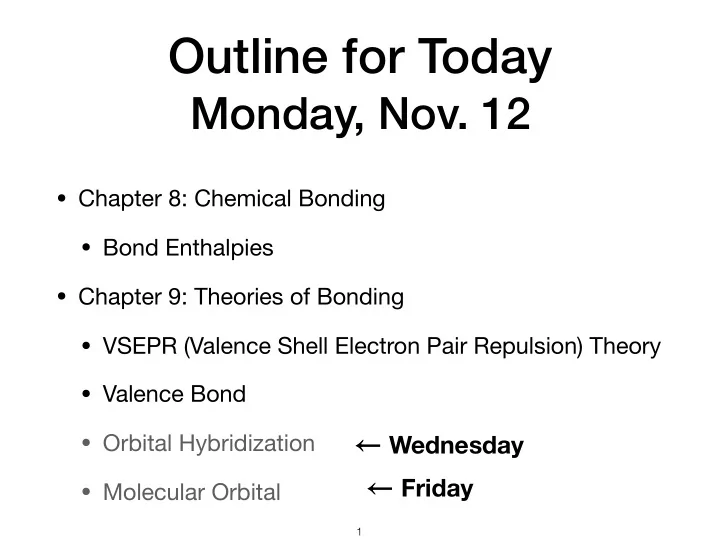

Outline for Today Monday, Nov. 12 • Chapter 8: Chemical Bonding • Bond Enthalpies • Chapter 9: Theories of Bonding • VSEPR (Valence Shell Electron Pair Repulsion) Theory • Valence Bond • Orbital Hybridization ⃪ Wednesday ← • Molecular Orbital ⃪ Friday ← � 1
Exceptions to the Octet Rule Odd number of electrons? Use resonance structures and formal charge to guide your decisions. 1. NO 2. NO 2 3. Superoxide: O 2- Chapter 9 Spoiler Alert! Lewis Structures aren’t great at describing radicals! We’ll learn about a better model next week called Molecular Orbital Theory!
Procedure To Draw Lewis Structures 1. Count the total valence electrons . Include overall charge. 2. Write the atomic symbols . Connect with single bonds. A. The central atom is usually written first. B. Central atom is usually the least electronegative. 3. Complete octets around all atoms using lone pairs or multiple bonds. Make sure you don’t exceed total valence electrons! 4. Check formal charges . Can rearranging electrons lead to formal charges closer to zero? 5. Consider breaking the octet rule for elements row 3 and below if it leads to better formal charges . 6. Multiple possible electron configurations? Consider resonance structures!
Bond Strengths and Bond Enthalpies • Bond Enthalpy : The energy it takes to BREAK a bond. • Related to bond strength and bond length. • As the number of bonds between atoms increase, the bond becomes shorter and stronger. It takes more energy to break it.
Bond Strengths and Bond Energies Energy to Break a Bond
Using Bond Enthalpies to Estimate Enthalpy of a Reaction ∆ H rxn = 𝚻 ∆ H bonds broken — 𝚻 ∆ H bonds formed Selected Values from Table 8.4 in your text Bond Enthalpy Bond Enthalpy Bond Bond (kJ/mol) (kJ/mol) C—H 413 C=C 614 C—C 348 O=O 495 C—O 358 C=O 799 O—O 146 N=N 418 C ≡ O O—H 463 1072 C ≡ N N—H 391 891 N ≡ N C—N 293 941
Example Problem: Bond Enthalpies Use bond enthalpies to estimate the ∆ H for the combustion reaction of CH 4 (methane). 1. Balance the Reaction 2. Draw out Lewis Structures for all molecules 3. Look up Bond Enthalpies 4. Use ∆ H rxn = 𝚻 ∆ H bonds broken — 𝚻 ∆ H bonds formed
On your note card… 1. Your Name 2. On one side, draw a picture or diagram that is important to your understanding of drawing Lewis structures. 3. On the other side, write a 2-3 sentence summary of how to draw lewis structures.
Molecules are Three Dimensional Objects How do we go from two dimensional Lewis structures to three dimensional shapes?
Chapter 9: Molecular Bonding Theories • Guiding Questions about each bonding theory: ‣ How does it work? ‣ What assumptions are made? ‣ What are the strengths and weaknesses? • Theories: 1. Valence Shell Electron Pair Repulsion Theory ( VSEPR ) 2. Valence Bonding 3. Hybridized Orbitals 4. Molecular Orbital Theory
VSEPR Shapes are based on how many Electron Groups are around an Atom 2 Electron 3 Electron 4 Electron Groups Groups Groups Linear Trigonal Planar Tetrahedral 180 o 120 o 109.5 o
109.5 o 107 o 104.5 o
Be sure to study Tables 9.2 and 9.3!
Putting it together: Molecular Geometry for Polyatomic Molecules Alanine, an amino acid: 4. C 1. C O H H H C C H O C H 3. N N 2. O H H What is the electron domain geometry of each atom indicated with an arrow?
Putting it together: Molecular Geometry for Polyatomic Molecules Alanine, an amino acid: 4. C 1. C O H H H C C H O C H 3. N N 2. O H H What is the molecular geometry of each atom indicated with an arrow?
Putting it together: Molecular Geometry for Polyatomic Molecules Alanine, an amino acid: 4. C 1. C O H H H C C H O C H 3. N N 2. O H H What is the approximate atomic bond angles of each atom indicated with an arrow?
VSEPR Shapes are based on how many Electron Groups are around an Atom 5 Electron 6 Electron Groups Groups Trigonal Bipyramidal Octahedral 90 o , and 120 o 90 o
Dipoles of Three Dimensional Molecules
Valence Bond Theory According to Valence Bond theory: Covalent bonds are a result of the overlap of atomic orbitals of the valence electrons Strengths : Does an orbital overlap does a good job at explaining why bonds form between 2 atoms. Weaknesses : Does not work well for predicting 3D shapes of molecules with 3 or more atoms.
Recommend
More recommend